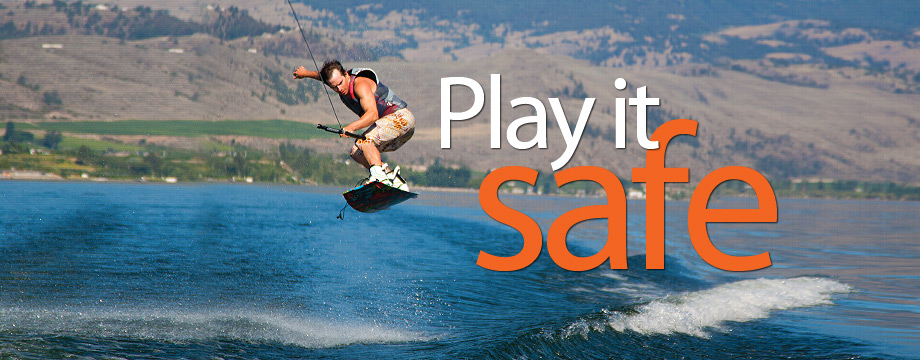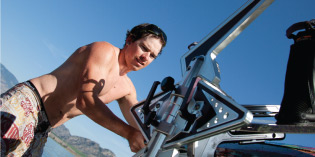 On a July evening in 2013 Penticton resident Rene Bourque and his female companion, both standing at the windshield of his 28-foot cabin cruiser, approached the Penticton City Wharf. The only illumination on the pier at 10:30 p.m. was a red navigation light located at the end. It blinked every six seconds. Rene says he throttled down to 20 kilometres an hour, saw the dock and thought it was further out. Too late. The boat hit the dock and ended up perched on the Kiwanis Walking Pier. Luckily, neither he, his passenger nor the young people on the pier were hurt.
On a July evening in 2013 Penticton resident Rene Bourque and his female companion, both standing at the windshield of his 28-foot cabin cruiser, approached the Penticton City Wharf. The only illumination on the pier at 10:30 p.m. was a red navigation light located at the end. It blinked every six seconds. Rene says he throttled down to 20 kilometres an hour, saw the dock and thought it was further out. Too late. The boat hit the dock and ended up perched on the Kiwanis Walking Pier. Luckily, neither he, his passenger nor the young people on the pier were hurt.
Near the end of August, Kelowna resident and former Kelowna Packers hockey player Patrick Mangold took his Jet Ski for a spin on Okanagan Lake after sunset. The craft struck a log boom near Trader’s Cove and Patrick was thrown, sutaining a fractured skull that rendered him unconscious. A nearby boater found him floating face down in his PFD. He was rushed to hospital, but could not be resuscitated.
On the evening of September 11, Abbotsford resident Dominic Cox was returning to the Penticton Marina with six friends after several hours of wakeboarding on Okanagan Lake. Dominic was kneeling on the bow when he fell off and was struck by the boat. Thanks to the collaborative efforts of Penticton Search and Rescue, Vernon Search and Rescue and the side-scan sonar equipment of Idaho-based Ralston and Associates, his body was finally recovered on October 10.
 Common risks
Common risks
All-too-frequent water related incidents like these share several risk factors. They all happened after dark and they all involved men. Both Patrick Mangold and Dominic Cox drowned, while the other accident could easily have ended in drowning. Several additional factors added to the danger of each situation. In the case of Rene Bourque, alcohol may have been a factor. “Bourque’s blood-alcohol level was at the cusp of being just over or under the legal limit,” says Penticton RCMP Media Relations Officer Cpl. Dan Moskaluk. “He was not charged.” The BC coroner determined that “intoxication from alcohol” and “low light conditions” contributed to Patrick Mangold’s Jet Ski crash. And Dominic Cox was not wearing a PFD.
The BC Coroner’s Service summary of accidental drowning deaths from 2008 to 2012 reports more than 81 per cent of drowning victims were male, 50 per cent were engaged in a recreational activity at the time of injury/death, and alcohol and drugs were contributing factors in about 40 per cent. Interior Regional Coroner Larry Marzinzik says men usually take more risks than women when on the water and also engage in more water related activities such as jet skiing or wakeboarding.
A 2011 Tourism Kelowna survey reports that 88 per cent of visitors participated in activities at beaches, lakeside parks or in the water. People flock here from other parts of the province and country for stand up paddling, kayaking, canoeing, swimming, sailing, river tubing, powerboating, wakeboarding and water skiing. Most enjoy their recreation safely; however, from 2008 to 2012 the Interior accounted for the highest rate of BC drowning deaths, 35.5 per cent. As of August 29, 2013, 40 per cent of BC drownings occurred in the Interior, with the majority of those in Okanagan Lake.
Get the card. It’s the law
Throughout Canada the Pleasure Craft Operator Card is mandatory for anyone operating a powered water vessel, with fines for non-compliance up to $287. Do the math. A lifetime license, easily obtainable online, takes about three hours of your time and costs $50. Money well spent for safety.
The course is designed for both novice and experienced boaters aged eight years and up. Following the course, participants take a Transport Canada approved exam and receive a temporary Pleasure Craft Operator Card. The permanent card is mailed within three weeks.
As far as knowing who is actually taking the test? “It’s a matter of probability,” says Robert Duval, spokesperson for Transport Canada’s Boaterexam.com.
Two significant oddities of the program irk some residents and pose questions about actual safety. Visitors from outside Canada who are operating a foreign-owned boat for less than 45 consecutive days do not require the card. Nor do people renting boats (although some rental companies have made it their policy); it is left to the rental company to take them through the safety rules, and the completed Rental Safety Checklist must be carried on the boat.
Make it so
Both RCMP and conservation officers have the responsibility of checking boaters, adding extra personnel during the summer months. Two reservists, retired RCMP officers, do the majority of the work. Up to 10 other fully trained officers assist them throughout the summer. Conservation officers are out there with them, and there’s work enough for everybody. It seems to take a while for some boaters to get the message.
One weekend in June 2013, RCMP checked 26 boats on Kalamalka Lake. Only 10 were compliant with safety features such as the proper number of lifejackets for the people on board or having a license. Conservation officers on Okanagan Lake checked eight boats. None were in compliance with regulations. However, by the end of July Vernon-North Okanagan RCMP spokesperson Gord Molendyk says the number of boating infractions dwindled significantly after patrols started at the beginning of the month.
“We’re out on the water on the major lakes every long weekend and try to be out every weekend during the summer,” he says. “We’re hoping to expand to the South Okanagan and the Kootenays for summer 2014.…Officers assigned to boat patrol do the best job they can considering the number of lakes and boaters in our area.”
Awareness is key and the patrol efforts are paying off. “Every year we are finding fewer and fewer infractions, more compliance. People who were approached in the past, and warned, have got the message. People now realize they will be checked and want to avoid the $287 fine. They must be operating their boat in a safe and sober manner. A powerboat is a motor vehicle. You cannot drive impaired.”
Photos by Laurie Carter




0 Comments